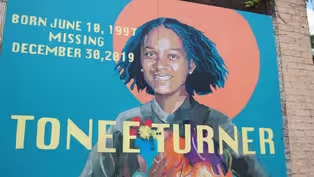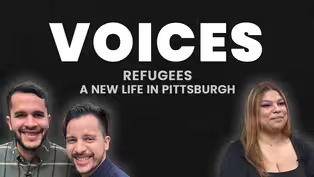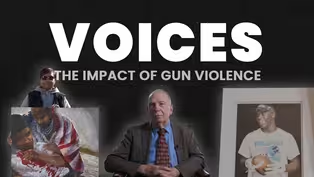
VOICES: Art of the Streets
7/14/2023 | 9m 58sVideo has Closed Captions
Graffiti artists and community leaders who are working to overcome negative perceptions.
From cave art to the birth of hip hop to rumbling freight trains, graffiti is a time honored form of human expression that has both thrilled and angered the public. In this episode of VOICES, we meet graffiti writers, artists and community leaders who are actively working to overcome the art form’s negative perceptions through the creation of legal graffiti walls, youth workshops, and events.
Problems playing video? | Closed Captioning Feedback
Problems playing video? | Closed Captioning Feedback
More Local Stories is a local public television program presented by WQED

VOICES: Art of the Streets
7/14/2023 | 9m 58sVideo has Closed Captions
From cave art to the birth of hip hop to rumbling freight trains, graffiti is a time honored form of human expression that has both thrilled and angered the public. In this episode of VOICES, we meet graffiti writers, artists and community leaders who are actively working to overcome the art form’s negative perceptions through the creation of legal graffiti walls, youth workshops, and events.
Problems playing video? | Closed Captioning Feedback
How to Watch More Local Stories
More Local Stories is available to stream on pbs.org and the free PBS App, available on iPhone, Apple TV, Android TV, Android smartphones, Amazon Fire TV, Amazon Fire Tablet, Roku, Samsung Smart TV, and Vizio.
Providing Support for PBS.org
Learn Moreabout PBS online sponsorshipMore from This Collection
Video has Closed Captions
When a person of color goes missing, are they given the same consideration as other races? (11m 24s)
VOICES: Refugees: A New Life in Pittsburgh
Video has Closed Captions
Every year, hundreds of refugees arrive in Western Pennsylvania, hoping to start new. (7m 18s)
VOICES: The Impace of Gun Violence
Video has Closed Captions
While no two stories are the same, the impact of gun violence affects nearly everyone. (9m 38s)
Providing Support for PBS.org
Learn Moreabout PBS online sponsorship(bright music) - [Matt] It's that core desire within all of us as humans and humanity to leave some kind of legacy or to like have some kind of voice where I'm here, you know, I'm on the planet, I'm here.
I think that's the driving force behind graffiti.
- [Shane] Graffiti is in every country, you know, where there are people, there is somebody writing their name on something.
(bright music continues) - I grew up around a lot of murals, a lot of graffiti.
When I was in Chicago, it just had a much more developed scene towards spray can art and mural art.
At any corner store or corner of a wall, an alleyway was likely a legal graffiti spot.
It was just so much more part of everyday life.
Coming here and seeing a huge absence of like a Latinx population and a Mexican-American population, I was just kinda like, what?
Like, Pittsburgh doesn't have that?
- In Pittsburgh, it took literally until maybe like five to six, seven years ago, at the most, before the public really started accepting spray paint as an art form and like something that should be valued.
- I'm a multiracial person, my dad's black, my mom's white, like I felt very welcome in the graffiti community in ways that I, you know, didn't feel very comfortable in some other spaces.
- I'm originally from the New Kensington area.
Spray paint had a stigma attached to it back then, it wasn't an official medium, as far as the art community was concerned, but we didn't really care, we were just doing it for fun.
- Graffiti, the term comes from "graphein", which is sort of Greek for like to write or to inscribe.
So we think about graffiti as just writing, the act of writing on a public surface.
A lot of folks will talk about how cave paintings on to the first form of graffiti, so if that's the case, then that's existed as long as human beings have like existed.
If we're talking about graffiti in terms of inscriptions on public surfaces or inscriptions on trains, there's a genre called freight train monikers.
- They would write on trains or marking posts nearby or fences nearby directions, information on who would be a good person to trust, which houses you could trust and which routes to take.
In general, advising people on a journey and also saying, "Hi, I was here."
- Folks that rode the trains, itinerant people, you know, they were at the time called hobos.
- And those hobo writers picked up moniker names.
(upbeat music) (bright music) Graffiti is one of the many parts of hip hop that has taken a longer, longer path to get to the mainstream.
- I think about 1980 to the Mayor of New York at the time declared a war on graffiti and that was, you know, quite a bit after graffiti had started.
- Style writing, which predates hip hop, was absorbed into hip hop and that's kind of how we get a lot of these like funky styles because a lot of the graffiti from its origin is referencing cartoons, different posters, signage 'cause that's what kids saw.
- Here in Pittsburgh, you know, it was a bunch of skateboarders doing graffiti back in the day, and we all came from punk rock roots.
In the '80s, when hip hop was just coming out of like the major cities and rippling toward us, it was only natural to at some point pick up a can of spray paint.
- With hip hop being that a lot of break dancers and MCs and DJs were also graffiti writers, it was just building this community.
- [Matt] I think all cities have officers that are on the lookout for unsanctioned public art but, you know, Pittsburgh, they crack down hard.
(siren blaring) - I had no idea that a task force would bring so many charges against me.
From the time of my freshman year to my senior year, I painted gems all throughout the city.
In my senior year, I learned that the task force was reinstated and I quickly learned that I was their number one most wanted.
(gentle music) In the case of graffiti, people are very reactionary when they hear about cases where people are vandalizing things.
- Vandals, you know, go to jail, go to hell, like we don't want any of that stuff.
Oh, it's spray paint, we don't want graffiti on our building, whereas like we're painting stuff like the things you see behind me but people just see spray paint and they're like, "Vandalism," that's it.
- Because of that divide between the graffiti writers and the general population that has pushed a lot of the graffiti writers further and further into the corner, harsher that you charge graffiti writers, the harsher that you tell them that they are bad people, the more you make them into villains, the more they're gonna believe they're villains.
- When I got arrested, the vandal squad really didn't exist.
I was arrested in one section of town in Shadyside but they didn't connect any of the dots with all the other parts of town.
When that vandal squad became active, they started connecting different police departments in like Aetna or the South Side or Bloomfield.
- [Caitlin] Now the way the city code is written is it actually really incentivizes people to call the police and to ask for a punishment kind of model.
- What we can do is take this art form, take this community and use it for the better.
All those people receiving arrests for graffiti should be given just very, very high amounts of community service.
In the case of myself and Shane, we help run nonprofits so the more that they get to do community work and do nonprofit work, the more that they will understand their community.
(bright music) - We created this organization, Hemispheric Conversations: Urban Art Project.
(bright music continues) The goal is to have more opportunities to talk about what we want our city to look like.
We kind of shared a desire to really expand the conversation about graffiti and about street art in Pittsburgh because we see these mediums as really powerful ways to have bigger conversations about things like youth voice and just development, as well as thinking about the history and the future of post-industrial cities.
(bright music continues) - Really it was to start to have a legal area, like a sanctuary for people to paint, it slowly developed into doing whole tours, workshops and going into schools, doing murals with students.
- That's the nature of the whole graffiti scene is you get good at it after some time and then you pass along what you know down to the younger guys.
- We create a environment to really inspire creativity and like show kids like our history and culture, where we come from with the graffiti world and defeat the stigma that it's just all bad and criminal.
(upbeat music) - One spot that I could tell you about that's wide open to the public, you can go spray paint there anytime is over in Bloomfield at Trace Brewery, they have an alleyway there and folks that are learning can just go.
- Part of the motivation behind such a space is to create low risk opportunities for folks to do their work, including young people who just really need to practice to get good to experiment.
- I think there should be more places you should be allowed to do it because you're only gonna make it worse if you're complaining about graffiti by not having those spaces.
- Today, it's an official medium now, matter of fact, a lot of the jobs that I work on specifically request spray paint.
- Recent years, as graffiti and street art have become popularized and become like Instagrammable, have become parts of tourism regimes around the world, they're actually used as incentives for development.
There are billboards everywhere and no one really asked us whether or not they were allowed to be there.
- Art does not have to be legal to be art, and if anything, some of the most challenging and forward thinking art is the art that does not abide by any laws or structure.
- You wanted to become any kind of artist in any fashion, like the best way to do it is to create and get your name out there.
Don't create for anybody, create for yourself.
(bright music)
Support for PBS provided by:
More Local Stories is a local public television program presented by WQED














